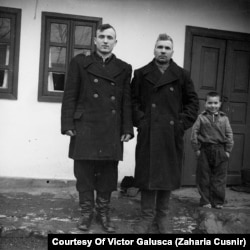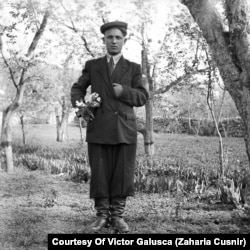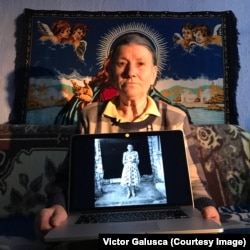One year ago, RFE/RL published the story of Zaharia Cusnir, an unknown Moldovan photographer whose work depicting rural Soviet life lay literally rotting in a village house until its discovery by film student Victor Galusca.
Since the story was published, Galusca has kept a close eye on comments left on a Facebook page he is curating dedicated to the work of Cusnir. Several people in the photographs have been identified -- mostly by social-media users who recognize their older relatives in the pictures. As a result, Galusca has been able to meet with six now-elderly Moldovans from Cusnir’s photographs.
Here, in Galusca’s words, are what each person told him:
Tamara Cusnir
She is a distant relative of Zaharia Cusnir and lived in the same village. Although she remembers the photographer as an "intelligent, very interesting person," she mainly spent time with his daughters, so knew Zaharia only as an authority figure in the house of her friends.
She fell in love with an accountant from a collective farm who was coming and going from the village on Soviet military service. But eventually he chose another woman and Tamara lost touch with him. It’s a romance that is not forgotten. She had a photograph of him in her private collection that she let me see. After I met with her, I found the accountant living in another village. His name is Vasile Tokarchuk.
Vasile Tokarchuk
He was sure he would marry Tamara. He remembered how beautiful she was. They used to spend evenings down by the river talking into the night. Even Tamara’s father wanted her to marry him. But one day they had an argument, and he decided she wasn’t for him.
But he never forgot Tamara. I saw some photos that Tokarchuk had kept from his youth. One print I recognized and noticed that he had cut her out of the frame.
Now his wife has died, and Tamara’s husband has, as well, so they are free. I want to offer to reunite them, perhaps in the village where their romance began.
Axenia Bulhac
She knew about the photo because her relatives had seen it online, but when I gave her a print as a kind of Christmas present, she was very happy. She was looking for a place in the house to hang it.
I know she worked in a kindergarten and looked after children. Unfortunately, we couldn’t communicate much because her hearing is gone. We just smiled and shared a cup of tea after I gave her the print.
Sergiu Cebotari
When I showed him the images, he started to cry. He worked all his life as a postman. Now he’s very weak and can only lie in bed.
He first got to know the photographer after Cusnir loaned Cebotari his bicycle -- a rare and precious object in Soviet Moldova -- and the youngster returned it in perfect condition with a bottle of wine as a gift. That first interaction created the trust that became a close friendship, and he later became a part of Cusnir’s family.
Cebotari was in the same class as one of Cusnir’s three daughters and fell in love with her during their school days. The two were married with Cusnir’s blessing and lived happily. But Ioana died in 2019 and, since then, Cebotari’s health has deteriorated.
He told me from his bed, “This isn’t life.” He’s only waiting to die.
Vera Borsh
Cusnir only photographed her twice, so she didn’t remember him well, but she recalled exactly why the photo was taken.
She had made the dress herself. Once she had finished sewing it, she went looking for Cusnir so he could take her photo in her new clothes. He was the only photographer for many kilometers around, so she had to seek him out.
She didn’t say anything about having a hard life. I gathered she just lived the simple existence of rural Moldovan people.
Aurel Sarmaniuc
He is one of around 300 people still living in the village of Rosietici, but he and his son are thinking of relocating to Germany or somewhere else to work. His son owns 200 sheep, but it’s getting too hard to manage them. He claims the shepherds they have hired are alcoholics and the work is getting too hard for Sarmaniuc to do himself.
Sarmaniuc and his wife were amazed when they saw the photo. You can see in the portrait the toe of his shoe is split. His wife was teasing him, saying, "What is with your shoes? If I had known you went around with broken shoes, I never would have married you!"
Galusca is seeking more people who recognize themselves in Cusnir’s photographs and would like to make a documentary film about the photographer's remarkable legacy.




















